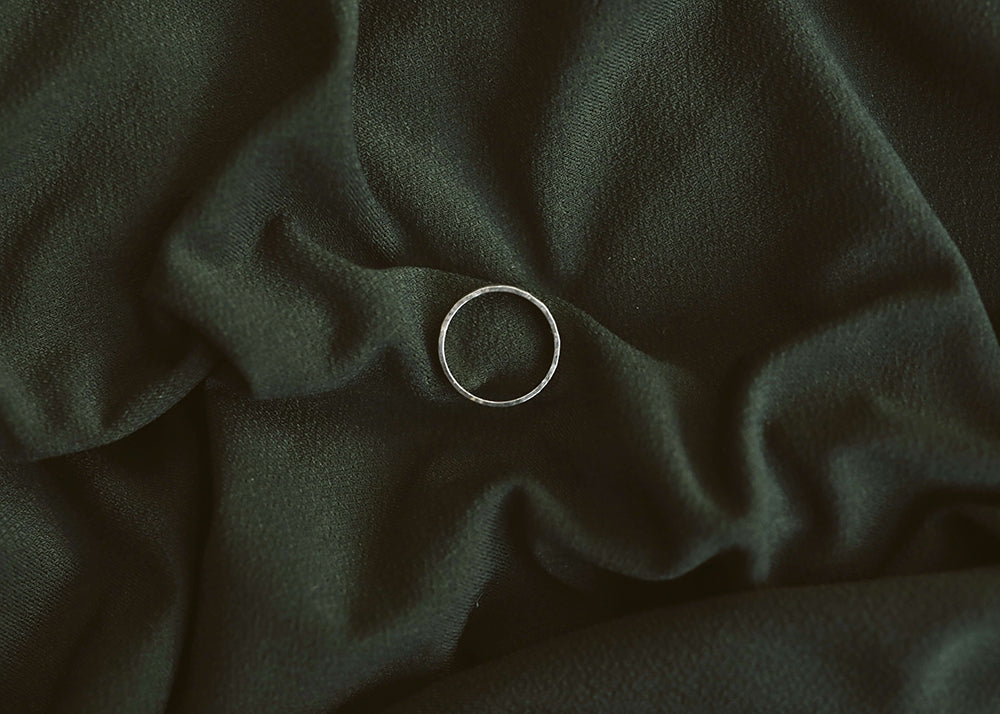Have you ever spotted a gorgeous sterling silver ring or pendant that just spoke to you? Maybe it had an almost ethereal, elvish quality or looked plucked straight from a medieval fantasy. But then you sighed, reminded yourself of your "acidic skin," and regretfully walked away?
You're not alone.
It has been a common myth for years that some people simply can't wear silver jewelry without it tarnishing or leaving gross green stains on their skin. And, no matter how much you loved a piece, you probably talked yourself out of it to avoid the disappointment.
But here's the surprising truth: that "acidic skin" thing is mostly a misconception. The real culprits are usually cheap alloys, lack of care knowledge, or environmental factors—not our bodies!
As a metalsmith trained by master goldsmiths, I've made it my mission to demystify this issue because, good news is, not all sterling silver is created equal. Some formulations are explicitly designed to resist tarnish and work better with a broader range of skin chemistries. Knowing what actually causes tarnish (and what doesn't) can help you choose pieces that truly work for your skin and your style.
So let's start by clearing up where that stubborn myth even comes from...

The "Acidic Skin" Myth Explained
It's easy to understand why people think they can't wear sterling silver. If you've had a ring that darkened quickly or a necklace that left a green mark on your skin, it's natural to blame your body chemistry. You may have even heard the term "acidic skin" thrown around like a diagnosis.
But here's the thing: tarnish and oxidation aren't always caused by your skin alone. They're usually the result of the copper content in standard sterling silver (92.5% silver, 7.5% copper) reacting with oxygen, moisture, or chemicals in the air.
And to make matters worse? A lot of mass-produced silver jewelry uses cheaper alloys that tarnish much more quickly. So, if you've had a piece darken almost overnight, it probably wasn't your skin—it was the metal. That's not your body being "too acidic."
That's just chemistry doing its thing.
What You've Been Missing Out On
If you've sworn off silver because of bad past experiences, you might've:
- Walked away from stunning rings, pendants or earrings that felt utterly YOU, whether they channeled medieval vibes, fantasy realms or your favorite fandoms
- Tossed still-fixable tarnished pieces, not realizing they could be restored
- Settled for blah stainless steel or gold-plated jewelry that didn't light you up
- Talked yourself out of custom designs you would've cherished
Essentially, you denied yourself the chance to express your identity and unique aesthetic through jewelry that felt deeply personal. And honestly, that's a crying shame!
Here's What's Actually Happening With Silver and Your Skin
Sterling silver is actually one of the BETTER options for people with sensitive skin; it's hypoallergenic for most! If you've had issues in the past, the problem might have been:
- A poor-quality alloy that oxidized too fast (it may have been sold as sterling silver but was actually not!)
- Alloys with high copper content react more aggressively with your environment
- Lack of proper care info (which is totally understandable because no one teaches this stuff!)
- High-humidity environments or trapped dirt or moisture underneath a ring band
But, many modern artisans, myself included, work with advanced silver alloys like Argentium, which are more tarnish-resistant and easier to care for. Others may use customized formulations or finishes to suit different skin chemistries and lifestyles.
You CAN Find Silver Jewelry to Love
Don't rule out sterling silver just yet! With the right information and expert guidance, you can absolutely find quality silver pieces without the fear of green stains and "acidic skin".
Now that you know silver isn't the enemy, here are some tips to ditch the "acidic" myth for good:
- Educate Yourself: Learn which silver alloys suit your needs and how to care for them. (Don't worry, I'll help!)
- Test Different Formulations: Try pieces made from higher-quality or tarnish-resistant silver to see how they perform.
-
Work With a Knowledgeable Jeweler: Someone who understands metal chemistry and your style can help you make the right choices.
How I Help You Find the Perfect Silver Jewelry
As a metalsmith, who trained under master goldsmiths, I'm passionate about creating beautiful, handcrafted silver jewelry that's also wearable and low-maintenance. I combine traditional and modern techniques to craft pieces designed for real lives.
If you've struggled with silver in the past, I'll help you explore the best formulations, finishes, and care options for your skin, lifestyle, and aesthetic. Every piece in my collection is designed with quality and intentionality because jewelry should be worn, loved, and lived in.
Wondering which type of silver might work best for you? Or dreaming of a custom piece you can wear with confidence? Let's talk.
A Final Thought
If you've had bad experiences with silver before, don't worry. You're not alone, and it doesn't mean silver isn't for you.
With the right formulation, finish, and care, sterling silver can be one of the most wearable, timeless, and expressive metals out there. You don't have to settle or give up on silver. So let's remake that scenario where you regretfully walked away from the sterling beauty that called to you. This time, you can say "yes" without hesitation and rock it like the queen you are!




